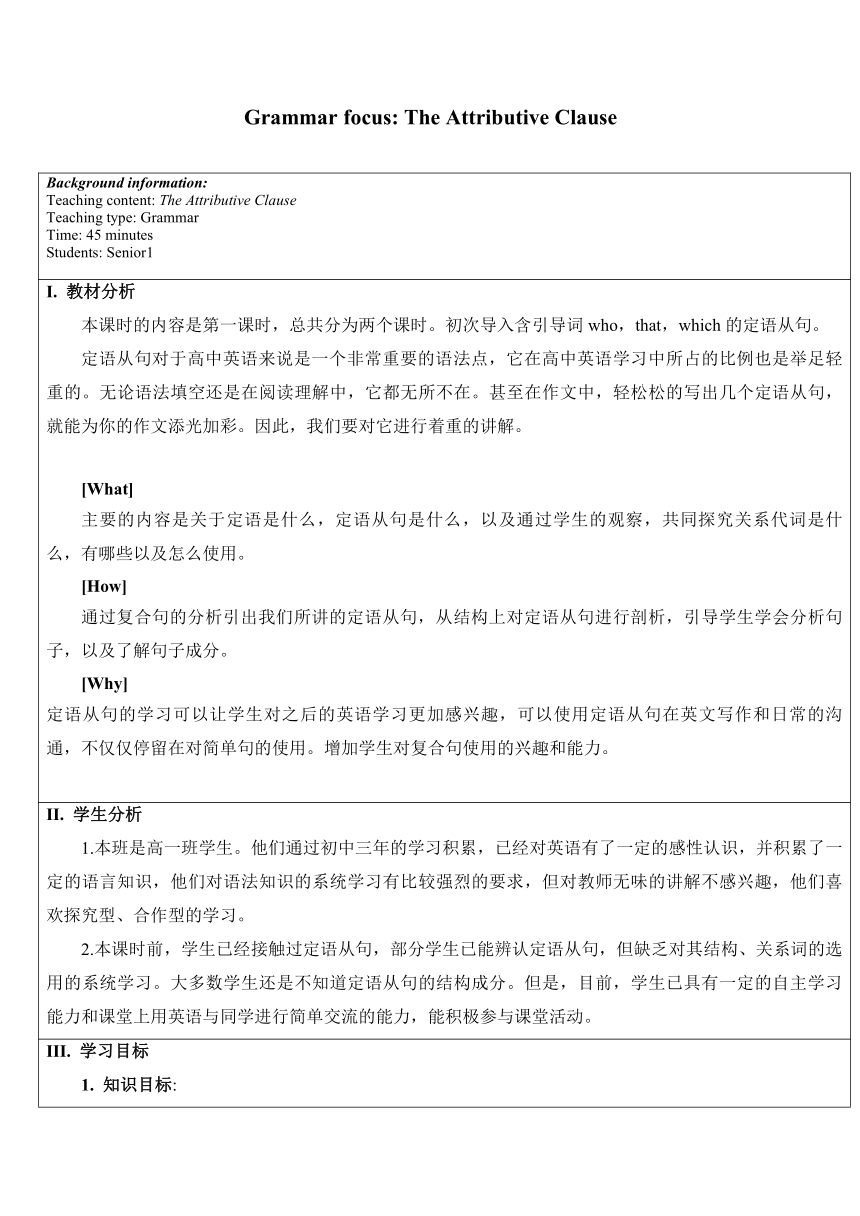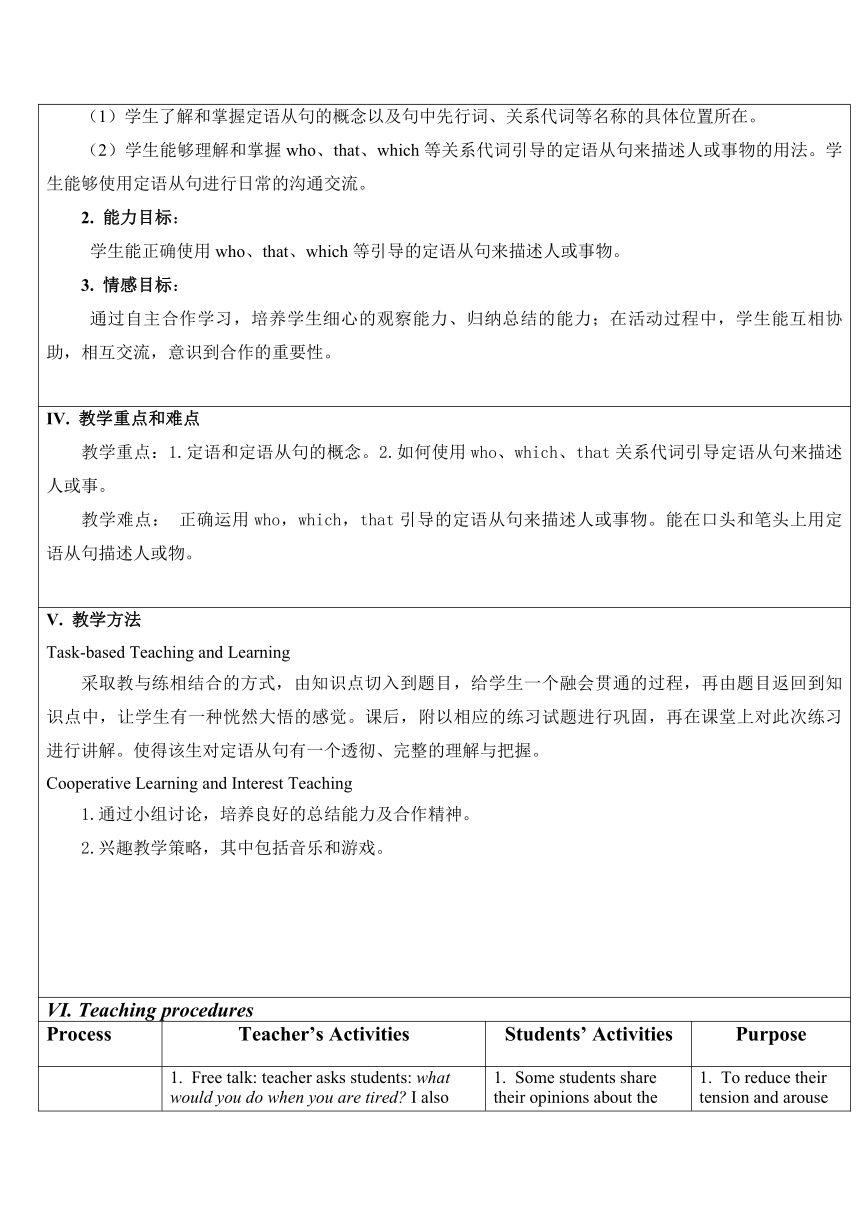牛津译林版(2019)必修第一册Unit1Back to School The Attributive Clause教学设计(表格式)
文档属性
| 名称 | 牛津译林版(2019)必修第一册Unit1Back to School The Attributive Clause教学设计(表格式) |

|
|
| 格式 | docx | ||
| 文件大小 | 40.7KB | ||
| 资源类型 | 教案 | ||
| 版本资源 | 牛津译林版(2019) | ||
| 科目 | 英语 | ||
| 更新时间 | 2024-03-14 09:57:07 | ||
图片预览


文档简介
Grammar focus: The Attributive Clause
Background information: Teaching content: The Attributive Clause Teaching type: Grammar Time: 45 minutes Students: Senior1
I. 教材分析 本课时的内容是第一课时,总共分为两个课时。初次导入含引导词who,that,which的定语从句。 定语从句对于高中英语来说是一个非常重要的语法点,它在高中英语学习中所占的比例也是举足轻重的。无论语法填空还是在阅读理解中,它都无所不在。甚至在作文中,轻松松的写出几个定语从句,就能为你的作文添光加彩。因此,我们要对它进行着重的讲解。 [What] 主要的内容是关于定语是什么,定语从句是什么,以及通过学生的观察,共同探究关系代词是什么,有哪些以及怎么使用。 [How] 通过复合句的分析引出我们所讲的定语从句,从结构上对定语从句进行剖析,引导学生学会分析句子,以及了解句子成分。 [Why] 定语从句的学习可以让学生对之后的英语学习更加感兴趣,可以使用定语从句在英文写作和日常的沟通,不仅仅停留在对简单句的使用。增加学生对复合句使用的兴趣和能力。
II. 学生分析 1.本班是高一班学生。他们通过初中三年的学习积累,已经对英语有了一定的感性认识,并积累了一定的语言知识,他们对语法知识的系统学习有比较强烈的要求,但对教师无味的讲解不感兴趣,他们喜欢探究型、合作型的学习。 2.本课时前,学生已经接触过定语从句,部分学生已能辨认定语从句,但缺乏对其结构、关系词的选用的系统学习。大多数学生还是不知道定语从句的结构成分。但是,目前,学生已具有一定的自主学习能力和课堂上用英语与同学进行简单交流的能力,能积极参与课堂活动。
III. 学习目标 1. 知识目标: (1)学生了解和掌握定语从句的概念以及句中先行词、关系代词等名称的具体位置所在。 (2)学生能够理解和掌握who、that、which等关系代词引导的定语从句来描述人或事物的用法。学生能够使用定语从句进行日常的沟通交流。 2. 能力目标: 学生能正确使用who、that、which等引导的定语从句来描述人或事物。 情感目标: 通过自主合作学习,培养学生细心的观察能力、归纳总结的能力;在活动过程中,学生能互相协助,相互交流,意识到合作的重要性。
IV. 教学重点和难点 教学重点:1.定语和定语从句的概念。2.如何使用who、which、that关系代词引导定语从句来描述人或事。 教学难点: 正确运用who,which,that引导的定语从句来描述人或事物。能在口头和笔头上用定语从句描述人或物。
V. 教学方法 Task-based Teaching and Learning 采取教与练相结合的方式,由知识点切入到题目,给学生一个融会贯通的过程,再由题目返回到知识点中,让学生有一种恍然大悟的感觉。课后,附以相应的练习试题进行巩固,再在课堂上对此次练习进行讲解。使得该生对定语从句有一个透彻、完整的理解与把握。 Cooperative Learning and Interest Teaching 1.通过小组讨论,培养良好的总结能力及合作精神。 2.兴趣教学策略,其中包括音乐和游戏。
VI. Teaching procedures
Process Teacher’s Activities Students’ Activities Purpose
Part I: Lead in (5 minutes) Free talk: teacher asks students: what would you do when you are tired I also like to listen to music. 2. Guessing game: Ask the students to listen to a song, and pay attention to the topic of the song. Then the teacher will tell the topic of the song is “She”. 3. Show a picture, and use some sentence to describe the woman, and introduced a sentence: She is the one that you never forget. The teacher can ask if we like someone, we will use some nice words to describe it. 4. The teacher will ask students what are the words that are being described Some students share their opinions about the topic of the song. Students need to think about the questions and they talk with their partners. To reduce their tension and arouse their interest of the class. 2. To lead in (a natural transition to the main sentence)
Part II: Presentation (25minutes) The definition of the attribute and attributive clause (10minutes) Ask the students to find out noun and pronoun. (名词或代词), and pay attention to some sentences, which part is described May be the nouns, the pronouns or noun phrases are described. Pay attention to some sentence. Let students observe some sentences and analysis the structure of the sentence. Then introduce the definition of the attribute. Let students pay attention to the position of the attribute, and conclude the rules of the position of the attribute. The teacher will ask students: Why a clause can be used as the attribute And pay attention to the a sentence: She is an actress who/that can speak English well. So, the teacher introduce the attributive clause. Analysis the structure of the Attributive Clause (定语从句)(15minutes) The teacher will give two sentences and combine. Introduce which part is attributive clause, and the definition of attributive clause. Let’ s go on: The teacher will give two sentences. let students put them into one. Observe and conclude: The teacher give two sentences, let students combine them into one, and analysis the structure of the sentence. 3. Analysis the structure of the attributive clause. The teacher will guide students to conclude and recognize what is the attributive clause, what is the position of the relative words and the position of the antecedent. 4. Let students know the attributive clause is used to describe the antecedent. 5. The teacher will tell students what is the antecedent, and what is the relative words, and their functions. 6. Then, give two activities and conclude the rules. Students can think about the questions and they talk with their partners. The students can work with their partners to observe and conclude the rules. 3. Students will be invited to share their opinions. Let students know the first step is to find out the nouns and pronoun in the attributive clause. Let students grasp the definition of the attribute and the attributive clause. To cultivate students to ability of the analysis. To cultivate the students grasp the main knowledge of the attributive clause. 5. To train the students’ cooperative ability.
Part III: Practice (10minutes) The teacher will let students do some exercises. Activity 3:Choose “who/which/that” (Group work). It includes four groups. They can answer at once. The question will be presented one by one. Activity 4: listen to music again and observe some sentences. Which part is left out. (the song includes the rules of omitting relative pronouns.) Then the teacher will guide students to observe and guess the rule of omitting the relative pronouns. Discuss and observe: When can we leave out the relative pronouns The teacher will invite some students to guess the answer of the question. Activity 5:Can “who/which/that”be left out Students can discuss with their group members. Students need to think positively, and answer the question followed by the guidance of the teacher. Students can do some exercises by themselves. To cultivate the students cooperative ability. To improve the students the ability of the observation. To cultivate the students learn to conclude rules. To let students learn to talk and think. To guide students use the attributive clauses in daily life.
Part IV Summary (3minutes) The teacher will summarize the definition of the attribute and the attributive clause. The function and choice of the relative pronouns be summarized. The teacher invite some students to try to summarize. Students can summarize the rule follow the teacher. Students can raise their hands to answer. To cultivate student’s summary ability.
Part V: Homework (2minutes) Make three sentences with what you have learned. Fill in the blanks. Ask students : Do you know some other words that can guide Attributive clause To consolidate what they have learned.
Blackboard design: Grammar------Attributive Clause Attribute Attributive Clause: Antecedent Relative pronouns: who/ which/that Groups: ABCD
Background information: Teaching content: The Attributive Clause Teaching type: Grammar Time: 45 minutes Students: Senior1
I. 教材分析 本课时的内容是第一课时,总共分为两个课时。初次导入含引导词who,that,which的定语从句。 定语从句对于高中英语来说是一个非常重要的语法点,它在高中英语学习中所占的比例也是举足轻重的。无论语法填空还是在阅读理解中,它都无所不在。甚至在作文中,轻松松的写出几个定语从句,就能为你的作文添光加彩。因此,我们要对它进行着重的讲解。 [What] 主要的内容是关于定语是什么,定语从句是什么,以及通过学生的观察,共同探究关系代词是什么,有哪些以及怎么使用。 [How] 通过复合句的分析引出我们所讲的定语从句,从结构上对定语从句进行剖析,引导学生学会分析句子,以及了解句子成分。 [Why] 定语从句的学习可以让学生对之后的英语学习更加感兴趣,可以使用定语从句在英文写作和日常的沟通,不仅仅停留在对简单句的使用。增加学生对复合句使用的兴趣和能力。
II. 学生分析 1.本班是高一班学生。他们通过初中三年的学习积累,已经对英语有了一定的感性认识,并积累了一定的语言知识,他们对语法知识的系统学习有比较强烈的要求,但对教师无味的讲解不感兴趣,他们喜欢探究型、合作型的学习。 2.本课时前,学生已经接触过定语从句,部分学生已能辨认定语从句,但缺乏对其结构、关系词的选用的系统学习。大多数学生还是不知道定语从句的结构成分。但是,目前,学生已具有一定的自主学习能力和课堂上用英语与同学进行简单交流的能力,能积极参与课堂活动。
III. 学习目标 1. 知识目标: (1)学生了解和掌握定语从句的概念以及句中先行词、关系代词等名称的具体位置所在。 (2)学生能够理解和掌握who、that、which等关系代词引导的定语从句来描述人或事物的用法。学生能够使用定语从句进行日常的沟通交流。 2. 能力目标: 学生能正确使用who、that、which等引导的定语从句来描述人或事物。 情感目标: 通过自主合作学习,培养学生细心的观察能力、归纳总结的能力;在活动过程中,学生能互相协助,相互交流,意识到合作的重要性。
IV. 教学重点和难点 教学重点:1.定语和定语从句的概念。2.如何使用who、which、that关系代词引导定语从句来描述人或事。 教学难点: 正确运用who,which,that引导的定语从句来描述人或事物。能在口头和笔头上用定语从句描述人或物。
V. 教学方法 Task-based Teaching and Learning 采取教与练相结合的方式,由知识点切入到题目,给学生一个融会贯通的过程,再由题目返回到知识点中,让学生有一种恍然大悟的感觉。课后,附以相应的练习试题进行巩固,再在课堂上对此次练习进行讲解。使得该生对定语从句有一个透彻、完整的理解与把握。 Cooperative Learning and Interest Teaching 1.通过小组讨论,培养良好的总结能力及合作精神。 2.兴趣教学策略,其中包括音乐和游戏。
VI. Teaching procedures
Process Teacher’s Activities Students’ Activities Purpose
Part I: Lead in (5 minutes) Free talk: teacher asks students: what would you do when you are tired I also like to listen to music. 2. Guessing game: Ask the students to listen to a song, and pay attention to the topic of the song. Then the teacher will tell the topic of the song is “She”. 3. Show a picture, and use some sentence to describe the woman, and introduced a sentence: She is the one that you never forget. The teacher can ask if we like someone, we will use some nice words to describe it. 4. The teacher will ask students what are the words that are being described Some students share their opinions about the topic of the song. Students need to think about the questions and they talk with their partners. To reduce their tension and arouse their interest of the class. 2. To lead in (a natural transition to the main sentence)
Part II: Presentation (25minutes) The definition of the attribute and attributive clause (10minutes) Ask the students to find out noun and pronoun. (名词或代词), and pay attention to some sentences, which part is described May be the nouns, the pronouns or noun phrases are described. Pay attention to some sentence. Let students observe some sentences and analysis the structure of the sentence. Then introduce the definition of the attribute. Let students pay attention to the position of the attribute, and conclude the rules of the position of the attribute. The teacher will ask students: Why a clause can be used as the attribute And pay attention to the a sentence: She is an actress who/that can speak English well. So, the teacher introduce the attributive clause. Analysis the structure of the Attributive Clause (定语从句)(15minutes) The teacher will give two sentences and combine. Introduce which part is attributive clause, and the definition of attributive clause. Let’ s go on: The teacher will give two sentences. let students put them into one. Observe and conclude: The teacher give two sentences, let students combine them into one, and analysis the structure of the sentence. 3. Analysis the structure of the attributive clause. The teacher will guide students to conclude and recognize what is the attributive clause, what is the position of the relative words and the position of the antecedent. 4. Let students know the attributive clause is used to describe the antecedent. 5. The teacher will tell students what is the antecedent, and what is the relative words, and their functions. 6. Then, give two activities and conclude the rules. Students can think about the questions and they talk with their partners. The students can work with their partners to observe and conclude the rules. 3. Students will be invited to share their opinions. Let students know the first step is to find out the nouns and pronoun in the attributive clause. Let students grasp the definition of the attribute and the attributive clause. To cultivate students to ability of the analysis. To cultivate the students grasp the main knowledge of the attributive clause. 5. To train the students’ cooperative ability.
Part III: Practice (10minutes) The teacher will let students do some exercises. Activity 3:Choose “who/which/that” (Group work). It includes four groups. They can answer at once. The question will be presented one by one. Activity 4: listen to music again and observe some sentences. Which part is left out. (the song includes the rules of omitting relative pronouns.) Then the teacher will guide students to observe and guess the rule of omitting the relative pronouns. Discuss and observe: When can we leave out the relative pronouns The teacher will invite some students to guess the answer of the question. Activity 5:Can “who/which/that”be left out Students can discuss with their group members. Students need to think positively, and answer the question followed by the guidance of the teacher. Students can do some exercises by themselves. To cultivate the students cooperative ability. To improve the students the ability of the observation. To cultivate the students learn to conclude rules. To let students learn to talk and think. To guide students use the attributive clauses in daily life.
Part IV Summary (3minutes) The teacher will summarize the definition of the attribute and the attributive clause. The function and choice of the relative pronouns be summarized. The teacher invite some students to try to summarize. Students can summarize the rule follow the teacher. Students can raise their hands to answer. To cultivate student’s summary ability.
Part V: Homework (2minutes) Make three sentences with what you have learned. Fill in the blanks. Ask students : Do you know some other words that can guide Attributive clause To consolidate what they have learned.
Blackboard design: Grammar------Attributive Clause Attribute Attributive Clause: Antecedent Relative pronouns: who/ which/that Groups: ABCD
